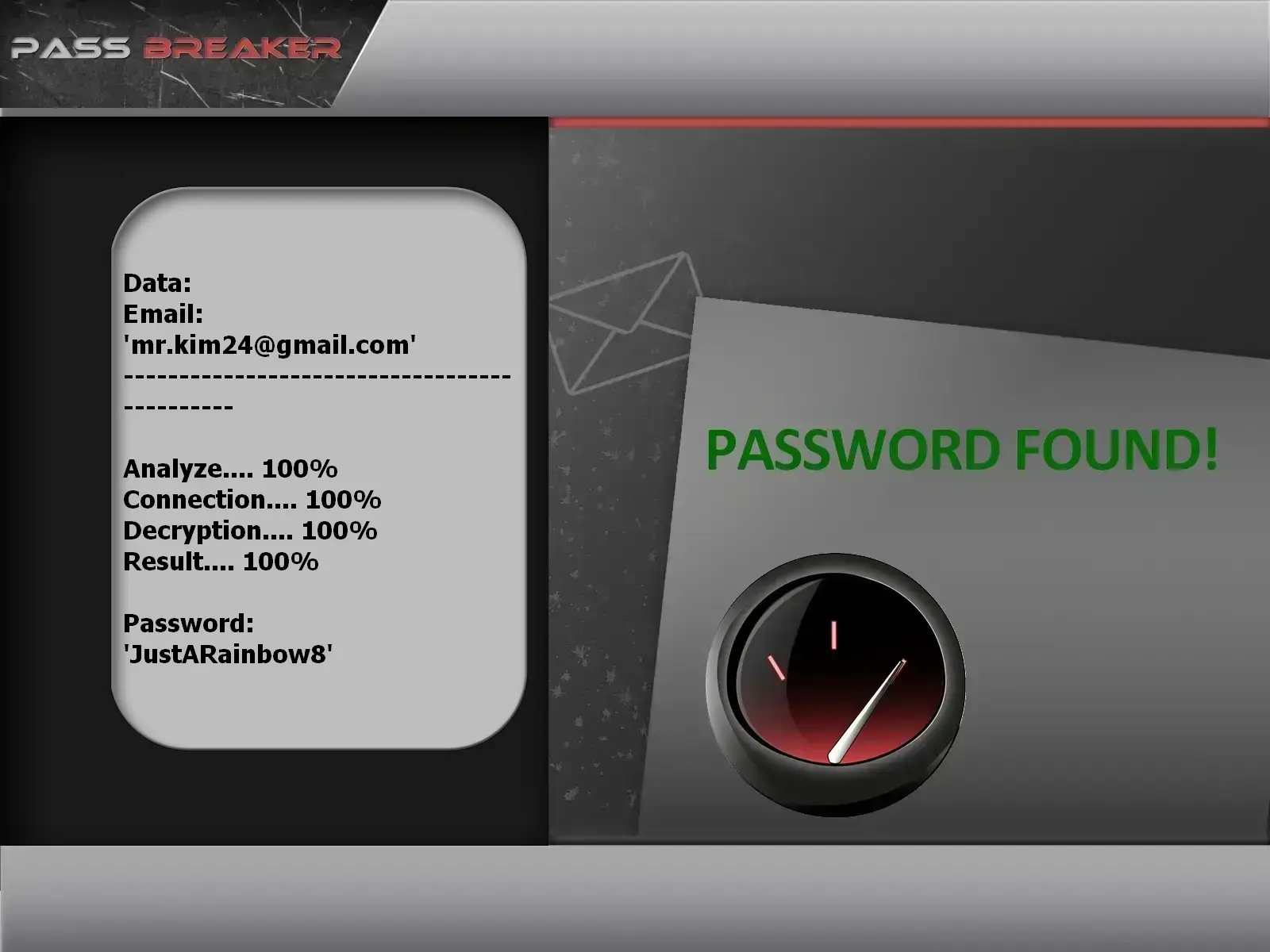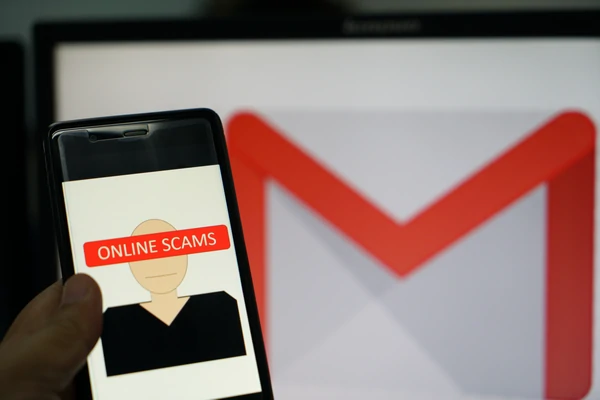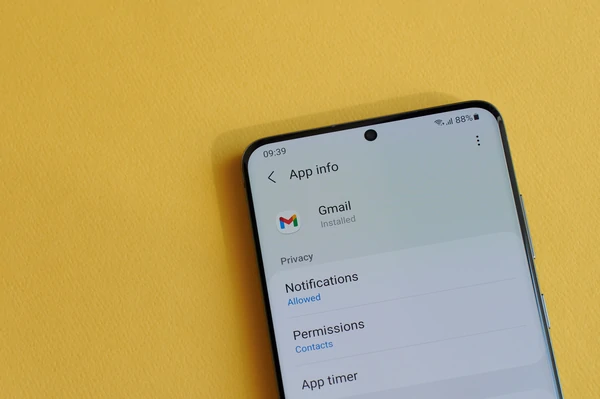GMail hacker tool
Hackers unveil their techniques

GMail hacker tool
Hackers unveil their techniques

The problem with these online tools is that everyone has at least one, which makes the risk of hacking more regular. On smartphone or computer, GMail is accessible on all platforms.
Google reports that 250,000 accounts are hacked per week. So why cracking GMail? Well there are several reasons...
At first, cracking GMail is possible, no one can deny it. But who cracks? Hackers are young, they were born in IT, some are graduates from top schools while others have nothing, they hack for fun or for money which is 99% the motivation of hackers.
They can gain access to emails to spy on competitors and resell the information. Also, they hack contacts' emails and they send their viruses to the whole list to make all their victims suffer the same fate.
The hackers don't have high-performance equipment as one might think, they have very simple computers that can be found on the market, they work from home on a sofa or from their bed! They do not hide in reality but are invisible on the Internet. Google tries to do everything to protect the data of their users but as soon as it comes to a username and password, the risk of hacking becomes higher and higher. Yet many find security flaws and help the company fix them. Google has even organized a contest and rewards hackers who have avoided the billion users from losing their data.
In the category of the most used applications in the world, GMail is undoubtedly one of the electronic services that we will certainly have the most difficulty doing without. With the explosion in the use of Android phones, having a GMail account has become a must. Hackers are interested in it and it is for this reason that we must tell you about the methods used to crack a GMail password. There are several categories of hacks and each of these methods will depend on the level of mastery of the person who wants to initiate the hacking.
There are methods that involve the use of applications and others that do not.
Let's take a closer look at them:

Developed by cybersecurity experts, PASS BREAKER is by far one of the most effective tools for regaining access to a GMail account. It’s extremely easy to use and doesn’t require any technical expertise—in other words, anyone can use it quickly and effortlessly at any time.
Simply follow these three steps:
- Download and install PASS BREAKER on your device from its official website: https://www.passwordrevelator.net/en/passbreaker
- Next, enter the email address of the target account or the phone number associated with it to initiate the password search.
- Start the search. PASS BREAKER handles the rest by performing an in-depth scan of relevant databases to locate the password for the desired account. Within just a few minutes, the password will be displayed in plain text on your screen.
The application remains highly effective and is used worldwide by thousands of people.
You can try it for a full month. At the end of this trial period, either it works, or you get your money back.
In the category of the use of applications, here is a selection of software commonly used to crack a GMail password:
These are applications that have utility in the personal sector as well as in the professional sector. Indeed, we regularly use cloning applications to transfer data from the old terminal to another in record time. These are the tools that save time, without taking the risk of forgetting some data in the old terminal. Hard drive cloning programs are widely used by professionals. Especially in this time when ransomware attacks proliferate more and more. Thanks to these IT solutions, it is possible to make backups of our data on time and in an exhaustive manner. In the event of computer attacks for example or a few system failures, we can be sure of being able to recover them serenely. However, this ability to copy the accuracy of one system to another is very problematic, especially in the face of ever-quick-witted and ingenious cyber malevolence.
Imagine that a hacker manages to install a cloning application on your smartphone or computer without your knowledge. This gives it great opportunity to copy everything you do, which of course includes your login credentials. Here lies the danger of an application that was basically very useful on a professional and personal level.
This method consists of creating counterfeits of legitimate applications. Indeed, hackers make counterfeit applications that we use daily. This may be antivirus, photo and video applications, or applications for connecting to e-mail accounts such as GMail. Most often, these are computer programs whose graphic identity and name strongly resemble the official application. But a trained eye will see some differences. Unfortunately, most users are not vigilant and these kinds of applications really work. If you accidentally use them, of course you imagine that hackers can have access to your login credentials and hack you.
There is some software designed typically to extract data from one computer system and send it to another. Like cloning software, it is not software that is the basis of malware. These are computer programs that have been corrupted due to improper use. For example, it is not uncommon to use data extractors for the purpose of scraping (collecting public data on the web for the purpose of carrying out studies, statistical analyses, etc.). However, in the realization of its practices, the use can unfortunately deviate. And it is in this context that we most often end up in cyber-maliciousness. The most difficult thing about this kind of application is that they are not illegal, in other words, you can find them even on legitimate websites such as Facebook, Instagram or even YouTube. Some of these extractors can be installed on your device without your knowledge and will not even be detected by your antivirus as malware.
The screen recorder is a computer program that allows you to record everything that happens on the screen of a computer or a smartphone. After the registration is completed, it is automatically sent to the hackers who installed it on your terminal. If you accidentally started a login procedure on your GMail account, hackers will know exactly what credentials you used. In turn hackers will then be able to log into your account and hijack it.
Basically, the screen recording software was developed to fill a weakness of another malicious program: the keylogger.
As its name suggests, the keylogger is essentially used to capture all of what is typed on the keyboard of a terminal to send it to its malicious operator. However, Keylogger cannot do the same when it comes to virtual keyboard. Which is a big weakness that the screen recorder compensates for.
Surveillance software is not malware at its core, rather it is protection software. Unfortunately, hackers have taken advantage of this to make hacking applications. Indeed, some applications hide under the guise of fake parental control software. Others take the form of spousal monitoring software. There are also some applications that are mobile tracings to find your smartphone or your computer or any lost computer device. If there is one thing that all these computer programs have in common, it is that they allow you to simply spy on you and this in a context that seems legal since there is a lot of equivalent software on the Google Play Store or on the App Store.
It is possible to collect information on the activity of the smartphone or the computer device concerned. This necessarily involves connections to social network or e-mail accounts such as GMail.
There are also versions of malicious applications known as " Stalkerware ". The latter are much more intrusive and much more effective in the context of hacking.
Most of these techniques using software obviously require enough effort to be installed on the endpoints of the users you are targeting. Indeed, no malicious computer program can work properly to steal data or crack passwords if it is not installed on your victim's terminal. For example, you can try to do it physically by installing the software yourself when the terminal is in your hands. There is also the phishing method which consists of tricking him into installing the software himself. Another solution can be used as the "stealth download". This method is the opposite of phishing since it prevents the user from clicking on a link. Indeed, it is itself redirected to a website and proceeds to download the malware without even realizing it because it is hidden. With much more experience and skills in hacking, the best solution will obviously be to use a software security flaw that has escaped the control of the manufacturer to initiate the famous type technique Zero Click (technique that allows an attack to be carried out on a remote computer terminal without even the direct and physical intervention of anyone without the knowledge of the user and the security software).
However, with PASS BREAKER, you don't even need to worry about such details because this program only installs on the terminal of whoever wants to crack the GMail password. It is not necessary to have another installation, just the email address or the telephone number is enough for the trick to be played.

More and more of us are connecting to WiFi networks every day without even knowing if it is dangerous or not. However, the danger is very real. WiFi networks are means of wireless Internet connection, which have been popular for the past 10 years. Behind this massive use, cyber malicious acts have gradually developed. It is possible to hack a GMail password using a WiFi network.
First of all, it is enough to create a WiFi network available for free without any protection. Indeed, most often WiFi networks are protected by codes of more than 8 digits which make it possible to determine who has the right to connect or not. But in our case, the hacker will make access free. Computer hackers most often target public places such as cafeterias, hotels, waiting rooms or even airports, that is to say the places where people start to spend time and connect to the Internet.
Then they wait patiently for unsuspecting people to connect to their network. The malicious operator hiding behind the fake WiFi Hotspot has the traffic monitored, hijacks its victims' sessions and collects all the data. All this in total discretion and without any user noticing.
Finally, once the data has been collected, the hacker will try to hack you.
The particularity of cookies (apart from the disturbing messages that often annoy us when we connect to web platforms) allows us to access a previous connection without spending too much time to resolve notification concerns if we use an application web or mobile. We can compare cookies to beacons that show the way to our terminal when browsing the web, especially if we want to retrace our steps on websites already visited before. To some extent, cookies allow us to save time. Of course hackers have understood this and they know how to use these same cookies to access your online account without even trying to find out our login credentials. As cookies record the path of our connections in order to facilitate our access later, hackers then seek to hack cookies in order to reproduce this path. As soon as they manage to get their hands on these small firmwares, they can perform two types of actions:
In other words, your security depends on how you preserve your cookies. After each connection, to avoid being trapped by this practice, it is particularly advisable to delete the cookies saved by your browser or by your application.
It is a very simple practice that doesn't require to be a specialist in computer hacking. You can steal someone's GMail password from their browser. If this person uses, for example, Google Chrome and is used to saving their login credentials in the manager of this browser, all you need to do is:
Of course, for this method to be successful, two conditions must be met:
In terms of data leakage, big platforms like GMail are literally bad students. Indeed, the examples of data leaks that this platform has been accused of are similar to those suffered by Outlook and Yahoo!. Indeed there have been many data leaks concerning GMail that have never been made public. Having such masses of data in circulation that can be retrieved by anyone is a threat that should not be overlooked. Indeed, hackers are constantly on the alert insofar as there is this kind of data leak. If hackers manage to recover information from your GMail accounts, they can use it to initiate computer attacks. Precisely "the attack on the dictionary". The dictionary attack is a cybercrime technique that involves repeated and constant testing of login credentials in order to find which ones will match the targeted accounts. The login credentials used here are stored in the " dictionary ", a storehouse of data meant to populate an automated password-finding script.

In view of the existing hacking methods, you need to find a way to improve the security of your GMail account and https://myaccount.google.com/security-checkup. So here are some tips that could definitely help you:
GMail hacker tool refers to various methods and software used by hackers to gain unauthorized access to GMail accounts.
GMail password tools are typically not recommended for legal and ethical reasons. Using such tools to attempt to access someone else's account without their consent is illegal and can result in severe consequences.
While it is technically possible to crack a GMail password, it is illegal and unethical to do so without proper authorization. Additionally, Google and other email service providers employ robust security measures to protect user accounts.
Using online hacking techniques to gain unauthorized access to GMail accounts can result in legal consequences, loss of personal data and damage to one's reputation. Additionally, it violates the privacy and security of individuals.
To protect your GMail account, it is recommended to use a strong and unique password, enable two-factor authentication, keep your devices and software up to date, use a VPN when accessing GMail on public networks and be cautious of suspicious links and emails.